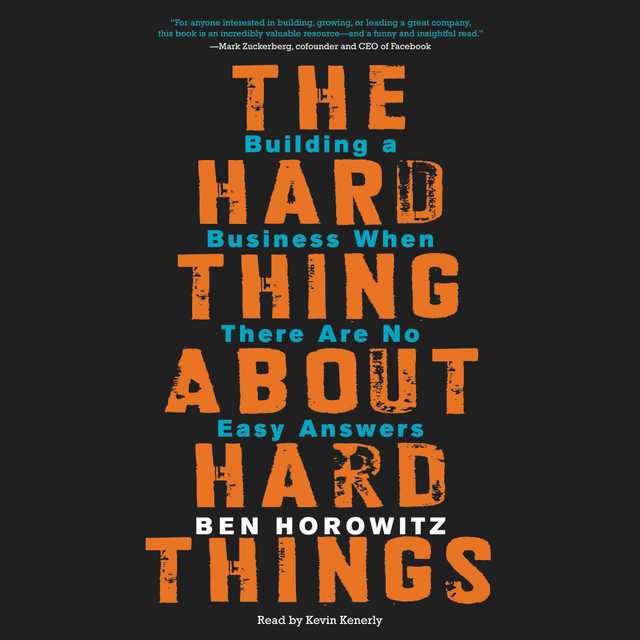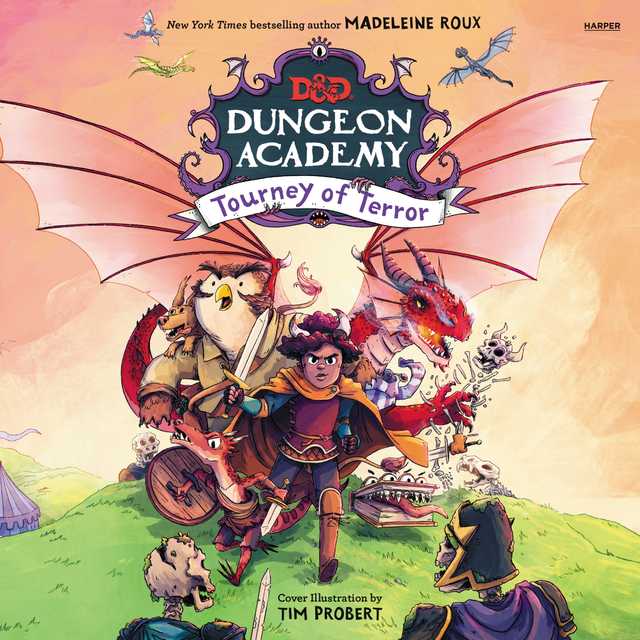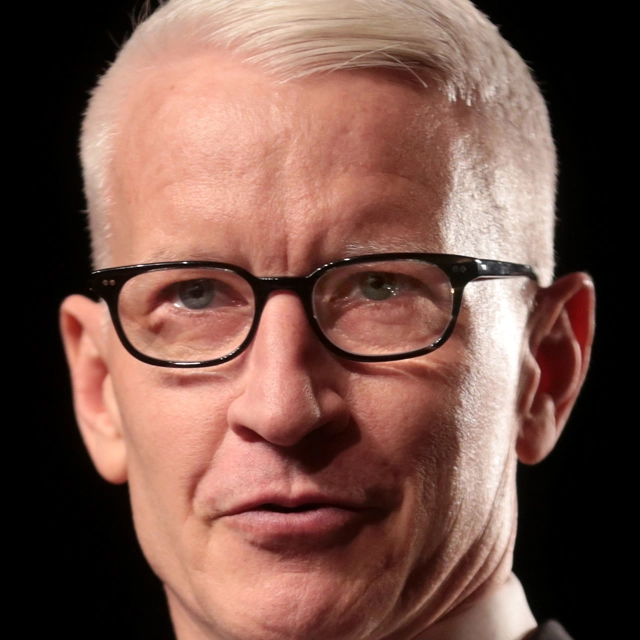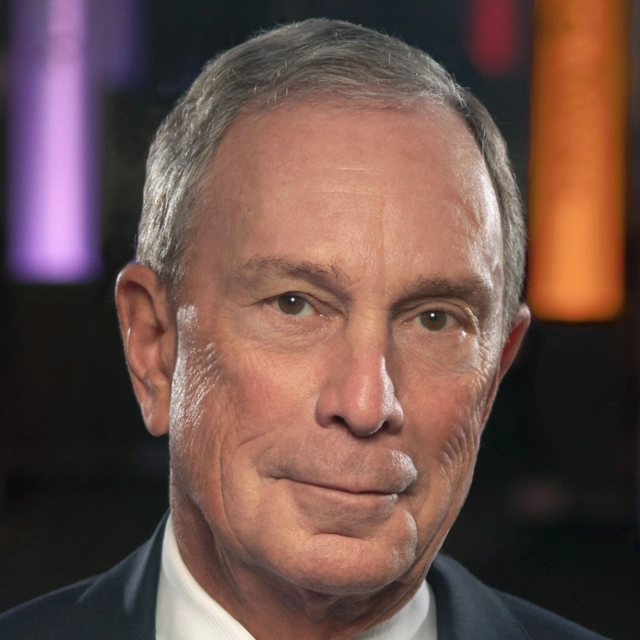Recommended by 1 experts
The Hard Thing About Hard Things Audiobook Summary
Ben Horowitz, cofounder of Andreessen Horowitz and one of Silicon Valley’s most respected and experienced entrepreneurs, offers essential advice on building and running a startup–practical wisdom for managing the toughest problems business school doesn’t cover, based on his popular ben’s blog.
While many people talk about how great it is to start a business, very few are honest about how difficult it is to run one. Ben Horowitz analyzes the problems that confront leaders every day, sharing the insights he’s gained developing, managing, selling, buying, investing in, and supervising technology companies. A lifelong rap fanatic, he amplifies business lessons with lyrics from his favorite songs, telling it straight about everything from firing friends to poaching competitors, cultivating and sustaining a CEO mentality to knowing the right time to cash in.
Filled with his trademark humor and straight talk, The Hard Thing About Hard Things is invaluable for veteran entrepreneurs as well as those aspiring to their own new ventures, drawing from Horowitz’s personal and often humbling experiences.
Other Top Audiobooks
The Hard Thing About Hard Things Audiobook Narrator
Kevin Kenerly is the narrator of The Hard Thing About Hard Things audiobook that was written by Ben Horowitz
Ben Horowitz is the cofounder and general partner of Andreessen Horowitz, a Silicon Valley-based venture capital firm that invests in entrepreneurs building the next generation of leading technology companies. The firm's investments include Airbnb, GitHub, Facebook, Pinterest, and Twitter. Previously he was cofounder and CEO of Opsware, formerly Loudcloud, which was acquired by Hewlett-Packard for $1.6 billion in 2007. Horowitz writes about his experiences and insights from his career as a computer science student, software engineer, cofounder, CEO, and investor in a blog that is read by nearly ten million people. He has also been featured in the Wall Street Journal, the New York Times, the New Yorker, Fortune, the Economist, and Bloomberg Businessweek, among others. Horowitz lives in the San Francisco Bay Area with his wife, Felicia.
About the Author(s) of The Hard Thing About Hard Things
Ben Horowitz is the author of The Hard Thing About Hard Things
More From the Same
- Author : Ben Horowitz
- What You Do Is Who You Are
- Publisher : HarperAudio
- Abraham
- American Gods [TV Tie-In]
- Dead Ringer
- House of Sand and Fog
- Prey
The Hard Thing About Hard Things Full Details
| Narrator | Kevin Kenerly |
| Length | 7 hours 57 minutes |
| Author | Ben Horowitz |
| Category | |
| Publisher | HarperAudio |
| Release date | March 04, 2014 |
| ISBN | 9780062347992 |
Subjects
The publisher of the The Hard Thing About Hard Things is HarperAudio. includes the following subjects: The BISAC Subject Code is Business & Economics, Leadership
Additional info
The publisher of the The Hard Thing About Hard Things is HarperAudio. The imprint is HarperAudio. It is supplied by HarperAudio. The ISBN-13 is 9780062347992.
Global Availability
This book is only available in the United States.
The Hard Thing About Hard Things is recommended by
Mark Zuckerberg
Mark Zuckerberg is a business magnate & philanthropist.
For anyone interested in building, growing, or leading a great company, this book is an incredibly valuable resource
Goodreads Reviews
Brad
March 10, 2014
This is one of the best books you’ll ever read on entrepreneurship and being a CEO.If you are a CEO, read this book.If you aspire to be a CEO read this book.If you are on a management team and want to understand what a CEO goes through, read this book.If you are interested in entrepreneurship and want to understand it better, read this book.On Friday, I spent the entire day with about 50 of the CEOs of companies we are investors in. Rand Fishkin of Moz put together a full day Foundry Group CEO Summit. It used a format Rand has used before. We broke up into five different groups and has sessions on about ten total topics throughout the day. The groups were fluid – people were organized by category (alpha and beta) but then went to the topic they were interested in. There was a moderator for each session – the first five minutes was each CEO putting up one “top of mind” issue in the topic, and the then balance of the session (75 minutes) was the entire group spending between 5 and 15 minutes on each topic.It was awesome. We finished with a fun dinner at Pizzeria Locale. I drove home with my mind buzzing and arrived around 8pm to see Amy laying on the coach reading a book. So I grabbed by iPad and looked to see what was new on it.I’d pre-ordered Ben’s book so it was in slot number one. It felt fitting to start reading it.At 10:30 I was finished with it. The Hard Thing About Hard Things was the perfect way to cap off a day with the CEOs of the companies we invest in.Trust me on this one. Go buy The Hard Thing About Hard Things right now.Ben – thanks for writing this and putting 100% of your heart into it.
Otis
February 10, 2017
I haven’t read many (any?) books that are written by CEO’s for CEO’s. If you are a CEO, aspire to be a CEO, or really, manage anyone - you need to read this book. This quote is perhaps my favorite one from the book. At the top, nobody is there to tell you what to do. It’s easy to look at some leaders and wonder how they knew what to do to become so successful. Are they just really smart? The truth is that they likely did what everyone else in that situation has to do - get scrappy and just figure it out - and don’t give up."Great CEOs face the pain. They deal with the sleepless nights, the cold sweats, and what my friend the great Alfred Chuang (legendary cofounder and CEO of BEA Systems) calls “the torture.” Whenever I meet a successful CEO, I ask them how they did it. Mediocre CEOs point to their brilliant strategic moves or their intuitive business sense or a variety of other self-congratulatory explanations. The great CEOs tend to be remarkably consistent in their answers. They all say, “I didn’t quit.”My second favorite quote from the book speaks to one of the greatest challenges all entrepreneurs face: work/life balance. I like to say "work hard, play hard". But sometimes it's easy to forget the play part. Or to buy flowers once in a while. But the cost of those on your health or relationships can cost much more. "As a company grows, communication becomes its biggest challenge. If the employees fundamentally trust the CEO, then communication will be vastly more efficient than if they don’t."Ben had a lot of great advice on how to hire well, especially executives. Looking to avoid reactionary big company execs when you need someone who will come in and get stuff done proactively. Looking for people who can think on their feet and not make everything a nail for the hammer of their prior experience by asking “How will your new job differ from your current one?” Looking for people who are mission driven and use the “team” prism instead of the “me” prism. He also had advice about onboarding, and training.Hiring for strength instead of lack of weakness. I’ve definitely seen instances of this - where a candidate is great in some areas that we really need but isn’t great at everything. Knowing what you value most is critical here - and I fully admit - not easy to do."I’d learned the hard way that when hiring executives, one should follow Colin Powell’s instructions and hire for strength rather than lack of weakness."On hiring internally vs externally. Internal candidates across often do better, which is a great thing to think about when building a team. "when it comes to CEO succession, internal candidates dramatically outperform external candidates . The core reason is knowledge. Knowledge of technology, prior decisions, culture, personnel, and more tends to be far more difficult to acquire than the skills required to manage a larger organization."One of my favorite sections was "Managing strictly by numbers is like painting by numbers". No matter how well you instrument your metrics and goals, you can ever perfectly encapsulate everything you need your company to be doing. Innovation is often like this - with many big innovations the team will often struggle to find how it drives value as it doesn’t seem to hit the core metric. But they can all agree it will improve things. I think a big part of the CEO’s job is to have a strong product vision, and to not compromise on it. "I often see teams that maniacally focus on their metrics around customer acquisition and retention. This usually works well for customer acquisition, but not so well for retention. Why? For many products, metrics often describe the customer acquisition goal in enough detail to provide sufficient management guidance. In contrast, the metrics for customer retention do not provide enough color to be a complete management tool. As a result, many young companies overemphasize retention metrics and do not spend enough time going deep enough on the actual user experience. This generally results in a frantic numbers chase that does not end in a great product."Ben talked about the difference between CEO’s who can set direction for a company (often founding CEO’s) and those can can operationally run it as it grows. How great CEOs need to be good at both, and founding CEOs who don’t scale are those who don’t learn the operational side. And conversely, operational CEOs who don’t get good at making decisions about direction will fail. Ben talked about how "Some employees make products, some make sales; the CEO makes decisions." The strength of those decisions is built upon having data. Data about what customers think. Data about what employees think. Data about the metrics. A CEO has to be a constant data accumulating machine. Another nuance was that a CEO can make a decision at any point in time with the data they have now, identify what data would change their mind, and seek it out. "Great CEOs build exceptional strategies for gathering the required information continuously. They embed their quest for intelligence into all of their daily actions from staff meetings to customer meetings to one-on-ones. Winning strategies are built on comprehensive knowledge gathered in every interaction the CEO has with an employee, a customer, a partner, or an investor."Ben’s stories about Loudcloud and Opsware and the Hard Things he dealt with were impressive. I do think they spread too much throughout the book and would have been better concentrated in one part of the book and supplemented by more examples from other companies. But that doesn’t detract from one can learn from them. It was strange that he opens each chapter with rap lyrics - that often seem very disconnected to the chapter. I guess he likes rap - but still…Pretty cool Ben had Michael Ovitz as an advisor. And that he modeled A16Z after CAA - where instead of independent agents/VCs, have a shared network - and invest in strategic networks that will help the companies. Michael Ovitz on dealmaking: “Gentlemen, I’ve done many deals in my lifetime and through that process, I’ve developed a methodology, a way of doing things, a philosophy if you will. Within that philosophy, I have certain beliefs. I believe in artificial deadlines. I believe in playing one against the other. I believe in doing everything and anything short of illegal or immoral to get the damned deal done."One interesting tendency Ben points out is that “When a company starts to lose its major battles, the truth often becomes the first casualty.”. You have to be vigilant in looking for the truth, and have backbone spot it. The reason for this, is that "humans, particularly those who build things, only listen to leading indicators of good news." Which is so true! We can always find reasons to excuse away bad news, and reasons to believe good news means more than it should. Ben closes with a quote I really believe in - life is about the journey, not the destination. So you have to embrace the journey. Be so mission driven that the struggles you inevitably face are worth it. "Life is struggle.” I believe that within that quote lies the most important lesson in entrepreneurship: Embrace the struggle."
Christopher
April 19, 2014
This is the very best business book I have ever read.I would estimate that I've read roughly 1,000. I've loved maybe 100. This one is in it's own category, a book that both documents the times about 12-15 years ago and paints a picture of what we can do today.I cannot recommend it highly enough, and I cannot say more strongly: read it. If you know me - email me at my personal address and I'll buy it for you. There are a few things that happen to an entrepreneur. I've faced down the belly of the 'no cash, people might find out that we are phonies' thing a few times, but this adds a vocabulary to the emotions that I've felt off and on all my life. These are my people, this is what I aspire to be, how I aspire to live, and the journey I aspire to take.Some will say that the book is for funded startups - and I'm a 'hustler for life'. I say nonsense: the struggle scales. It is just as scary fighting for your own personal livelihood as it is fighting for the jobs of 300 people.There is practical information: how to conduct a review, how to live your life how move forward.I can't say more strongly: if anything I've said has ever moved you over the years go out and buy this book.A couple things: I missed my spot on the standby list because I was so engrossed in this book. I *literally* cried during a story of how they dealt with an employe's cancer during a merger.
Patrick
January 26, 2015
It's hard for me give this a rating, as I haven't really read many other how-to business books. I liked the narrative section at the beginning of the book a bit better than the tactical advice section, but I think that's probably just how I prefer to get information. There are some great lessons in here for non-CEOs, but I suspect it's even more valuable for those who have founded and/or run a company. I think most relevant and/or interesting to me were:* Hiring for strength rather than lack of weakness. If you're bringing someone new onto the team, really think hard about what strengths are most important for the job and find someone who is world class at those things. If that person isn't as strong at everything else on your check-list, don't sweat it.* Importance of one-on-ones as a management technique. It's sort of incredible that people can manage without one-on-one meetings, but I guess it happens. The big breakthrough (or at least, the one that I hadn't put into words before) is that it's the employee's meeting, rather than the manager's. I mean, duh, but still a good framework for thinking about the meeting.* As a CEO, you don't have time to develop your direct reports. I suspect this is really difficult for many CEOs to deal with at first. I know it would be tough for me. But it makes sense -- at that level, you just have to be able to do the job with minimal-to-no developmental runway.Anyway, for my first management book, this one was fun and readable and very honest. Also lots of hip-hop quotes, for those who roll that way.
Josh
March 15, 2015
I rarely read the same book twice, but I'm going to do just that with this book. In fact, I'm considering reading it once a month for the next year until everything in it is ingrained in my consciousness. Why? Because this book has the lessons I need in my business, right now. I'm in the midst of hiring my core team that is going to help us grow. I've gone through, and continue to go through, many of the challenges faced by Horowitz, albeit with fewer zeros on the ends of all the numbers. This book has definitely made it into my "top 10 books all entrepreneurs must read" list. I only give five stars to books I believe everyone should read. This book isn't a must-read for everyone, but if you're an entrepreneur it has five stars for you.Update March, 2015. I've read it three times. Starting on the fourth time. Yes, it's that good and useful.Update March, 2015. Four times. Every time I read it I learn several new things that are directly applicable to my business, right now.
Mario
June 03, 2020
Must read for any entrepreneur. Dives into the psychology of being a CEO and also full of practical business advice for managing a company during challenging times.
Christopher
September 08, 2019
"Hard things are hard because there are no easy answers or recipes. They are hard because your emotions are at odds with your logic. They are hard because you don't know the answer and you cannot ask for help without showing weakness." (Ben Horowitz, The Hard Thing About Hard Things, Page 274)Written by Billionaire Ben Horowtiz, founder and former CEO of Opsware. A silicone valley company, which he later sold to HP for 1.65 billion dollars. And he now is a venture capitalist, who funds mainly up and coming technology companies. Previously, he was a project manager at Netscape and has been in the silicone valley landscape his whole life.This book shares his struggles and successes as CEO of Opsware, and how he founded his venture capital firm with his partner Marc Andreessen, who is also a billionaire.There were instructions on how to hire the right CEO, how to find the right employees, if you should keep or sell your company, how to handle performance management, dealing with shareholders...Basically, he built a technology company and sold it for a billion dollars and now does venture capitalism. The trend I am seeing in reading billionaire books is that they build a company of value, take it public, generate millions and sometimes billions of dollars, sell it for millions or billions and then take life a little more easy and become an authority on business. This is the same story repeated here.
Maciej
December 06, 2019
The Hard Thing About Hard Things talks about being a CEO during peacetime and wartime. The book is written by Ben Horowitz, an American investor and a technology entrepreneur. Actually, the whole book is the journey through his founding of the company called Loudcloud which was the first major company offering cloud storage. Today all big companies, such as Apple, Google, Amazon, Microsoft are doing that, but the Loudcloud was really the first one which connected a cloud with computing. The company was founded in 1999 and soon after it quickly grew to hundreds of employees and millions in revenue along with other Internet-based companies which peaked in value until March 2000. Then the burst of the bubble happened, also known as the dot-com crash and many online shopping companies and communication companies have evaporated from the market. Cisco, for instance, declined by 86% from around $80 to $15. In order to survive, he went to IPO, transformed the company into Opsware, an enterprise software company and finally sold to Hewlett-Packard for $1.6 billion in cash.Anyway, it is not a book about the dot-com bubble but, in my opinion, about the difference between being a leader and an CEO in the period of prosperity and during the financial crisis. It might be also comparable to being a CEO of the top company in your industry versus running the company which is 20th in everything. There are a lot of books talking about peacetime, about being nice to people, having great goals, credos etc. There are also some books about wartime, nevertheless, there are almost no studies which addresses the duality which might occur. So as the book says the methods are completely different, in peacetime you have to be idealistic, paying attention to every, to be super nice to your employees, never curse or anything like that. As a wartime CEO, you have to curse on purpose to emphasize your point. Of course, it doesn’t mean that during wartime you have to be a jerk. You always have to understand the importance of creating a good work environment in a company and taking care of the people to ensure the team works effectively and efficiently towards the company’s goals. In both cases, you have to be a great problem solver, as well as, a quality-oriented manager. Nevertheless, the delivery, the timing and your behaviour have to be different.I really liked one of his stories when he, as an inexperienced wartime CEO, tried to pretend that everything is ok. He thought he had to be positive and suddenly, one day, he found out that his employees knew things were bad and a couple of them asked him why does he always have to keep pretending everything is perfect. They were not kids, they understood the situation. Here Horowitz wrote a lot about the most difficult skill for a CEO which is the ability to manage your own psychology.Last but not least, the book also talks a bit about how difficult it is to set a company without a real business connections in your circle and without experience in...(if you like to read my full review please visit my blog https://leadersarereaders.blog/the-ha...)
Matt
February 03, 2017
This book was a game changer for me. I started reading it in the middle of my biggest struggle as a founder and CEO of Neoteric (#32 on Deloitte Technology Fast 50 CE). It was recommended by my co-founder, Mateusz Paprocki.Ben shares tough stories here. He says what he fucked up and how did he manage to make it up. It helped me to trust my instincts and bet my decisions during company transformation on the values I live by. It's only 1 month since I started implementing the changes and I already see a huge improvement of both business and personal life.I wish I had read this book 2 years earlier. I recommend it to anyone who has entered fast growth. I hit the glass roof before adopting - you don't have to and this book can help you prepare.
Farhan
September 24, 2020
You start with a company and a clear vision, with success looming. Then you hire all the right people and create an environment that is stimulating and encouraging. And together, you work on the vision, creating the perfect product that customers are going to love. You work day and night, shed blood and tears to get this doneThen, you reach a point where you realize that not everything is going as smoothly as you expected. There's a problem with the product and it’s hard to fix, or the market has crashed, or your employees struggle and bail. It feels like the world around you is collapsingThere are no shortcuts to knowledge, especially knowledge gained from personal experience. Following conventional wisdom and relying on shortcuts can be worse than knowing nothing at allYou need two kinds of friends in your life. The first kind is one you can call when something good happens, and you need someone who will be excited for you. Not a fake excitement veiling envy, but a real excitement. You need someone who will actually be more excited for you than he would be if it had happened to him. The second kind of friend is somebody you can call when things go horribly wrong — when your life is on the line and you only have one phone call. Who is it going to be? Whenever a large organization attempts to do anything, it always comes down to a single person who can delay the entire projectWhen you are building a company, you must believe there is an answer. You just have to find itIf there is one skill that stands out, it’s the ability to focus and make the best move when there are no good movesMy single biggest personal improvement as CEO occurred on the day when I stopped being too positiveWe take care of the people, the products, and the profits — in that orderBy far the most difficult skill I learned as CEO was the ability to manage my own psychologyGiven this stress, CEOs often make one of the following two mistakes: 1. They take things too personally. 2. They do not take things personally enoughFocus on the road, not the wall. When someone learns to drive a race car, one of the first lessons taught is that when you are going around a curve at 200 mph, do not focus on the wall; focus on the roadGreat CEOs face the painWhenever I meet a successful CEO, I ask them how they did it. Mediocre CEOs point to their brilliant strategic moves or their intuitive business sense or a variety of other self-congratulatory explanations. The great CEOs tend to be remarkably consistent in their answers. They all say — I didn’t quitBest management book I’ve ever read — High Output ManagementWatered-down feedback can be worse than no feedback at all because it’s deceptive and confusing to the recipientFeedback is a dialogue, not a monologueThis is not checkers, this is motherfuckin’ chessPlay long enough and you might get luckyDon’t take it personallyMost business relationships either become too tense to tolerate or not tense enough to be productive after a whileAsk yourself — what am I not doingLife is struggle — Karl MarxWithout trust, communication breaksThe more brains working on hard problems, the betterBad news travels fast, good news travels slowFace your fearBe clear in your own mind about why you are laying people offBe visible, be presentAcknowledge the contributionsThere may be nothing scarier in business than facing an existential threat. So scary that many in the organization will do everything to avoid facing it. They will look for any alternative, any way out, any excuse not to live or die in a single battleIf our company isn’t good enough to win, then do we need to exist at all?Hire people with right kind of ambition (for company success)Build strict processes for potentially political issues and do not deviatePeter principle — in a hierarchy, members are promoted so long as they work competently. Sooner or later they will become incompetentLaw of Crappy People — for any title level in a large organization, the talent on that level will eventually converge to the crappiest person with that titleGo for shock when designing cultureCalming nerves — make friends, get it on paper, focus on the road (not the wall)2 skills to run organization: knowing what to do — getting company do to what you knowMeasure of quality of leader — quantity, quality and diversity of people who want to follow himTraits of leader:1) Ability to articular the vision2) Right kind of ambition3) Ability to achieve the visionIn good companies, the story and the strategy are the same thingShow it, sell it. Hide it, keep itEmbrace the strugglePeople will love you when they perceive that you care about themDon’t hide the company’s problems — you’ll gain trustPut first things firstI had to consider the people I liked most before I considered myselfI started being the person that I wanted to beWhen you need to fire someone, do it and do it quicklyAnd do it compassionatelyIf you treat the people who are leaving unfairly, those who stay will never trust you againDon’t let rumors spread, don’t let people be terrifiedAs a CEO you won’t be able to share all the burdens you have. But do share all the ones you canBuild a culture that awards people for getting problems in the open where they can be solvedThe maxim of — don’t bring me a problem if you don’t have a solution — is toxic. It leads people to hide all the issues they cannot solve, which are the ones most likely to wreak havocKeep great employees — especially when things are not going wellA manager only seeking to further his own status is extremely demotivating for good employeesInternal enemies of the organization:1) Feels disempowered2) Fundamentally a rebel3) Too naive and believe that everything wrong is management’s faultManager and employees one on one meetings are very importantEmployees should set the agenda and not the other way around and managers should do 10% of the talking and 90% of the listeningThat makes people feel heard and helps spot problems early, while also spreading good ideasYou’re not fooling anyone when you try to spin every single bad news into a positive one. Be honest instead about the company’s issues and challengesIt’s easy to look only at what’s going well and act on those positive results while ignoring or explaining away the things that aren’t going well. Avoid this trap. It will leave you with fewer insights and a strategy with potential holesNobody wants to hear your excuses about why something didn’t get done or didn’t go as planned. Instead of focusing on detailing what happened, focus on what you can do to improve the situation and do better next timeInstead of hiring for a lack of weaknesses, hire for strengths. So if someone has amazing technical capabilities and average communication skills, hire that person over the candidate who is good, but not great at either skillSet expectations for training and performance To have strong group communication, you need to define the process and structure of communications. For example, the expectations and purpose of every meeting should be very clearOn firing — You cannot let him keep his job, but you absolutely can let him keep his respectThere are two different kinds of CEOs — decision makers and implementersIn startups you only experience two emotions: euphoria and terror. Lack of sleep amplifies bothEmployees can handle loss much better because they aren’t married to the companyGive the problem to the people who can fix it, and would also be personally motivated and excited to solve itConfucius approach — the good of the individual must be sacrificed for the good of the wholeOne reason people quit — they hated their manager. They were appalled by the lack of guidance, career development, and feedback. They weren’t learning anythingThey weren’t learning anything — The company wasn’t investing resources in helping employees develop new skillsAs a great general manager, you must hire and manage people who are far more competent at their jobs than you would beAll decisions are objective until the first line of the code is written. And then they are emotionalShort-term, expedient decisions with expensive long-term consequences can lead to a management debtThe first rule of entrepreneurship — there are no rulesAdvice and experience can help guide usFlowers are cheap divorce is expensive Looking at the world through such different prisms helped me separate facts from perceptionI don’t believe in statistics. I believe in calculusStartups should train their people for: 1) Productivity2) Performance management3) Product quality4) Employee retentionAssemble the interview teamNothing motivates a great employee more than a mission that’s so important that it supersedes everyone’s personal ambitionThe CEO must set the context within which every employee operates. Well-structured goals and objectives contribute to the context, but they do not provide the whole story
Herve
May 19, 2014
“Every time I read a management or self-help book, I find myself saying, “That’s fine, but that wasn’t really the hard thing about the situation.” The hard thing isn’t setting a big, hairy, audacious goal. The hard thing is laying people off when you miss the big goal. The hard thing isn’t hiring great people. The hard thing is when those “great people” develop a sense of entitlement and start demanding unreasonable things. The hard thing isn’t setting up an organizational chart. The hard thing is getting people to communicate within the organization that you just designed. The hard thing isn’t dreaming big. The hard thing is waking up in the middle of the night in a cold sweat when the dream turns into a nightmare.The problem with these books is that they attempt to provide a recipe for challenges that have no recipes. There’s no recipe for really complicated, dynamic situations. There’s no recipe for building a high-tech company; there’s no recipe for making a series of hit songs; there’s no recipe for playing NFL quarterback; there’s no recipe for running for president; and there’s no recipe for motivating teams when your business has gone to crap. That’s the hard thing about hard things— there is no formula for dealing with them.”This is how begins The Hard Thing About Hard Things by Ben Horowitz [see page ix]. After a first chapter about his experience in start-ups (Netscape, LoudCloud), Horowitz gives advice to entrepreneurs. And it is not business school-like advice indeed. Marc: “Do you know the best thing about startups?Ben: “What?Marc: “You only ever experience two emotions: euphoria, and terror. And I find that lack of sleep enhances them both.[Page 21]Marc is Andreessen, the founder of Netscape, with whom he co-founded VC firm Andreessen Horowitz (a16z.com) in 2009.“People often ask me how we’ve managed to work efficiently across three companies over eighteen years. Most business relationships either become too tense to tolerate or not tense enough to be productive after a while. Either people challenge each other to the point where they don’t like each other or they become complacent about each other’s feedback and not longer benefit from the relationship. With Marc and me, even after eighteen years, he upsets me almost every day by finding something wrong with my thinking, and I do the same for hi. It works.” [Page 14]I began my review by quoting the first page. I will quote here with his final page: “Hard things are hard because there are no easy answers or recipes. They are hard because your emotions are at odds with your logic. They are hard because you don’t know the answer and you cannot ask for help without showing weakness. When I first became a CEO, I genuinely thought that I was the only one struggling. Whenever I spoke to other CEOs, they all seemed like they had everything under control. Their businesses were always going “fantastic” and their experience was inevitably “amazing”. But as I watched my peers’ fantastic, amazing businesses go bankrupt and sell for cheap, I realized I was probably not the only one struggling.” […] “Embrace your weirdness, your background, your instinct. If the keys are not there, they do not exist.”[Page 275]Again the book is not an easy read. It is more advice about processes than anything else, so you may not enjoy the book if you do not need to apply it now. If you are not an ambitious entrepreneur who needs to scale his venture, reading the book may not be useful. Still it is a great book. Let me give you a couple of examples.“Figuring out the right product is the innovator’s job, not the customer’s job. The customer only knows what she thinks she wants based on her experience with the current product. The innovator can take into account everything that’s possible, but often must go against what she knows to be true. As a result, innovation requires a combination of knowledge, skill, and courage. Sometimes only the founder has the courage to ignore the data.” [Page 50]Funnily enough, Horowitz quotes Thiel. (By the way, quotes on the back page supporting Horowitz’s book are from Page, Zuckerberg, Costolo and Thiel…) “I don’t believe in statistics, I believe in calculus”. And his advice “when things fall apart” are- Don’t put it all on your shoulders.- This is not checkers, this is motherfuckin’ chess.- Play long enough and you might get lucky.- Don’t take it personally.- Remember that this is what separates the women from the girls.I summarize his advice from pages 64 to 93 as when things fall apart, face the truth and tell the truth. Tell the truth to your employees, tell the truth to your future ex-colleagues, tell the truth to your friends and more importantly, tell the truth to yourself.I understand now why Andreessen-Horowitz is seen as a firm which has put in place tons of processes. Horowitz describes many tasks founders should be utmost careful about. Taking care of people, first. He also describes how you can do mistakes by trying to do good. Just one example: “our hockey stick [the shape of the revenue graph over the quarter] was so bad that one quarter we booked 90% of our new bookings on the last day of the quarter. […] I designed an incentive to closed deals in the first two months. […] As a result, the next quarter was more linear and slightly smaller… deals just moved from the third month to the first two months of the following quarter.”Other interesting examples are about smart people and bad employees. “Sometimes, you will have a player that’s so good that you hold the bus for him, but only him.” And senior (old) people: “When the head of engineering gets promoted from within, she often succeeds. When the head of sales gets promoted from within, she almost always fails”. [Page 172] Horowitz explains also there is not one rule, it is company-dependent. Andreessen favors giving titles easily, Zuckerberg has opposite views.“Perhaps the most important thing that I learnt as an entrepreneur was to focus on what I needed to get right and stop worrying about all the things that I did wrong or might go wrong.” [Page 200] Again focus on the strengths, not the weaknesses.Ones and TwosHorowitz quotes Collins’ “Good to Great”. “Internal candidates dramatically outperform external candidates.” And then adds that “Collins does not explain why internal candidates sometimes fail as well”. There are “two core skills for running an organization: First, knowing what to do. Second, getting the company to do what you know. While being a great CEO requires both skills, most CEOs tend to be more comfortable with one or the other. I call managers who are happier setting the direction of the company Ones and those who more enjoy making the company perform at the highest level Twos.” When they are not competent at both, “Ones end up in chaos and Twos fail to pivot when necessary.” [Pages 214, 216]Horowitz shows that great CEOs need vision like Steve Jobs had, competence in implementing like Andy Grove had, and ambition like Bill Campbell. One of Horowitz favorites references is indeed Andy Grove and his “High output Management.” Horowitz shows how much respect is has for Jobs and Campbell, but the systematic processes remain his favorite, therefore Grove.Wartime/peacetimeHorowitz also strongly believes that “life is struggle” (quoting Karl Marx) and that CEOs have to be ready to be both peacetime CEOs (when a company has a large advantage over competition in a growing market – Eric Schmid at Google until Page took over) and wartime CEOs (companies facing existential threats – Grove at Intel when they switched from memories to microprocessors or Jobs at Apple when he came back).“Be aware that management books tend to be written by management consultants who study successful companies during their times of peace. As a result, the books describe the methods of peacetime CEOs. In fact, other than the books written by Andy Grove, I don’t know of any management books that teach you how to manage in wartime like Steve Jobs or Andy Grove.” [Page 228]Horowitz hates the idea that founders should be replaced, that companies need professional CEOs who know how to scale companies or who “should be the number-one salesperson.” CEOs define the Strategy (“The story and the strategy are the same thing.”) and do Decision making (“with speed and quality”).You may like the “Freaky Friday Management Technique” [Page 252] and “Should You Sell Your Company?” [Page 257] but let me finish with some of his final thoughts: “First technical founders are the best people to run technology companies”. […] “Second, it is incredibly difficult for technical founders to learn to become CEOs while building companies.” [Page 268] Which is why VCs should help these founders becoming CEOs, by helping them acquire the skill set as well as building a network.Finally if you wonder why Andreessen-Horowitz web-site is www.a16z.com, you just have to count the number of letters in the name between the a and the z…
Most Popular Audiobooks
Frequently asked questions
Listening to audiobooks not only easy, it is also very convenient. You can listen to audiobooks on almost every device. From your laptop to your smart phone or even a smart speaker like Apple HomePod or even Alexa. Here’s how you can get started listening to audiobooks.
- 1. Download your favorite audiobook app such as Speechify.
- 2. Sign up for an account.
- 3. Browse the library for the best audiobooks and select the first one for free
- 4. Download the audiobook file to your device
- 5. Open the Speechify audiobook app and select the audiobook you want to listen to.
- 6. Adjust the playback speed and other settings to your preference.
- 7. Press play and enjoy!
While you can listen to the bestsellers on almost any device, and preferences may vary, generally smart phones are offer the most convenience factor. You could be working out, grocery shopping, or even watching your dog in the dog park on a Saturday morning.
However, most audiobook apps work across multiple devices so you can pick up that riveting new Stephen King book you started at the dog park, back on your laptop when you get back home.
Speechify is one of the best apps for audiobooks. The pricing structure is the most competitive in the market and the app is easy to use. It features the best sellers and award winning authors. Listen to your favorite books or discover new ones and listen to real voice actors read to you. Getting started is easy, the first book is free.
Research showcasing the brain health benefits of reading on a regular basis is wide-ranging and undeniable. However, research comparing the benefits of reading vs listening is much more sparse. According to professor of psychology and author Dr. Kristen Willeumier, though, there is good reason to believe that the reading experience provided by audiobooks offers many of the same brain benefits as reading a physical book.
Audiobooks are recordings of books that are read aloud by a professional voice actor. The recordings are typically available for purchase and download in digital formats such as MP3, WMA, or AAC. They can also be streamed from online services like Speechify, Audible, AppleBooks, or Spotify.
You simply download the app onto your smart phone, create your account, and in Speechify, you can choose your first book, from our vast library of best-sellers and classics, to read for free.
Audiobooks, like real books can add up over time. Here’s where you can listen to audiobooks for free. Speechify let’s you read your first best seller for free. Apart from that, we have a vast selection of free audiobooks that you can enjoy. Get the same rich experience no matter if the book was free or not.
It depends. Yes, there are free audiobooks and paid audiobooks. Speechify offers a blend of both!
It varies. The easiest way depends on a few things. The app and service you use, which device, and platform. Speechify is the easiest way to listen to audiobooks. Downloading the app is quick. It is not a large app and does not eat up space on your iPhone or Android device.
Listening to audiobooks on your smart phone, with Speechify, is the easiest way to listen to audiobooks.































